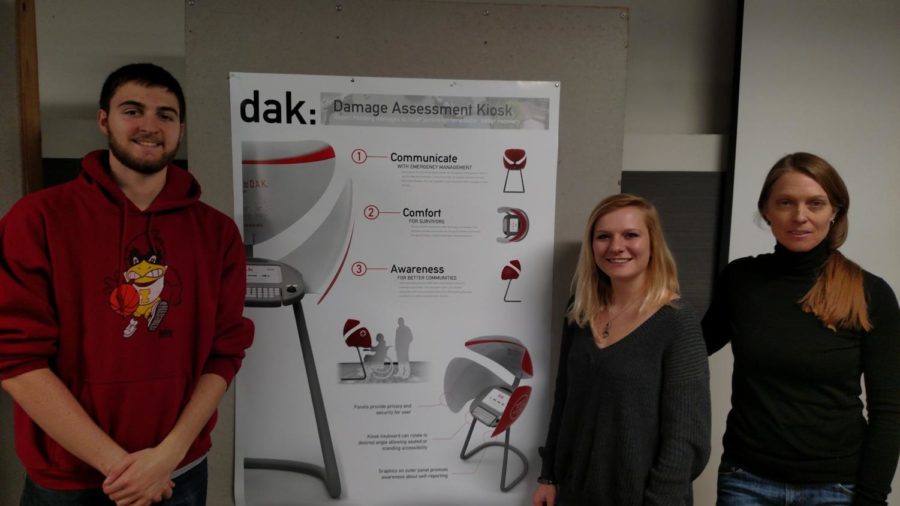Industrial design project envisions a new way to respond to emergencies
Michael Heckle/Iowa State Daily
Aaron Evans, junior in industrial design; Rachel Harksen, junior in industrial design and Verena Paepcke-Hjeltness, assistant professor for industrial design present their emergency response project.
January 10, 2017
It’s hard to imagine losing everything. Homes. Possessions. Family members. Sadly, that is the reality that many who experience disasters have to face.
But a group of Iowa State industrial design students have developed a new and more accurate way to assess the damage caused by disasters and offer survivors hope in the face of disaster.
Over the course of seven weeks, Aaron Evans, Rachel Harksen, Ran Duan and Zach Benjamin, all juniors in industrial design, designed the Damage Assessment Kiosk, a new way for survivors of emergencies to self-report damages to their homes and property.
The students designed the product as part of the fall 2016 industrial design junior studio instructed by assistant professor Verena Paepcke-Hjeltness. The class was broken up into four groups of four, each given a topic related to emergency response.
The projects focused on five broad areas in disaster and emergency responses: water sanitation and hygiene in emergency situations, emergency shelter components, rapid response capabilities, first responders report and after first responders leave.
“The brief was design a product or system for disaster relief, which is immensely broad,” Evans said. “If I were to give a summary of what our product is, it would be a damage assessment kiosk that allows flood survivors, or survivors of any disaster, to report their damages for a faster, better recovery.”
Evans said that, after talking to Keith Morgan, director for Story County Emergency Management, the group was able to narrow its sights on damage assessment after the first responders leave.
“The thing that stood out when talking to [Morgan] was that they send out these damage assessors after a disaster occurs and really they have no idea where the damage has occurred, who needs help the most, how much, in a dollar amount, has been damaged in the community,” Evans said.
Not knowing how much damage has occurred can be a real problem when it comes to rebuilding, Evans said. From the estimates provided by the Emergency Management Assessors (EMAs), directors like Morgan pass them up to the state level, where it is determined if a community qualifies for presidential aid.
“That process, because there is such a limited amount of people who are trained to do that, can take a very long time and can also be inaccurate in terms of how much money is actually getting into the hands of people who need it,” Evans said.
The students focused on the idea that homeowners know the most about their homes, and that by offering a platform to combine the knowledge of EMAs and homeowners, they could create a more accurate estimate of damages.
But the process of developing the kiosk was by no means easy. With such a broad topic, narrowing down exactly what issue to tackle became a real challenge for the students. When the group members settled on an idea, they found themselves face-to-face with the complex layers that make up disaster relief.
“It’s never just a clear straight line,” Paepcke-Hjeltness said. “Early on, you branch out and collect data and then you end up in this overwhelming state of you know too much.”
The Damage Assessment Kiosk is lightweight and portable, designed to be used by groups like the Red Cross in emergency shelters. It provides users with a simple, graphic-based system that communicates questions without the technical jargon, something the group discovered was a major problem in other disaster assessment applications.
It’s wide base and movable keyboard makes it handicap accessible, and the system itself is designed to accommodate survivors with mental disabilities.
The group also wanted the kiosk to feel welcoming, not intimidating. The kiosk not only provides a way to more accurately assess damages, but hope for survivors as well.
“I think it’s important because it gives safety to the people,” said Harksen. “It provides them comfort in a time they really, really need it. And, for me, that’s super important because if you’re not happy, how are you going to recover from that?”
Although the kiosk itself still needs more development to become a reality, the research put into it’s design could have a tangible effect on other emergency response applications.
“The feedback that we created on the existing products has been forwarded to the Iowa Department of Homeland Security because they partner with a contract to make them.” said Evans. “That is going to be moving forward and looked at.”







